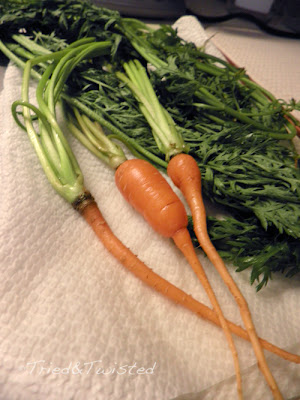I've dabbled in gardening now for two years and I just now think that I might know what I'm doing enough to know that knowing what I'm doing doesn't always help.
Take carrots for instance. They are a cooler season crop that are supposed to be pretty hardy. So I first planted them two years ago. Sad little crop. I researched and found they like sandy soil, so I worked in some organic matter into our clay soil and waited for a better harvest this year.
After extra tilling, I still only had three measly carrots in this year's crop.
Rather than walking away from the whole thing and letting those carrots go to waste, I noticed that while the carrots were quite small, the carrot leaves on top were fantastically large! The poor little veggie sent all his energy to the leaves instead of the tail, just like an upper body weight lifter who neglects his core and leg workout.
The Myth of Poisonous Greens
"But Sara," you might be asking. "What can you do with carrot leaves? I thought they were poisonous."Since I am alive to write this post to you now, I can honestly say...apparently not.
While I'm not an expert, I did do some research and couldn't find a single reason why carrot leaves would kill you. In fact, I found that many greens that we typically throw away are actually edible and sometimes contain as much or more nutrition than the actual root vegetable. Carrot leaves contain high levels of vitamin C, potassium, and calcium.
The reason most people do not use these parts isn't that they are poisonous, but that they have a perky bitter taste. So you can throw carrot greens on a salad for a little bitter kick, as if it were arugula, but not everyone likes bitter. In fact, for most Americans, it is the most neglected of all taste buds.
Juicing a Healthy Snack
So what to do with a healthy crop of carrot leaves and very little carrots? Juice it!We recently acquired a juicer through secretive, clandestine means (aka my coworker sold me her old one for super cheap). So now, I get to play with it and see how it works. You see, as a serious adult, kitchen gadgets are now like my new toys on Christmas morning.
Juicing is a great option to add extra nutrients to your diet or to eat a little healthier. It's quite popular for some people with dietary restrictions, too. However, it's rarely advisable to go overboard and drink all your meals through a juicer without consulting your doctor first, because the body does need fiber.
Plus, people might start to look at you funny when your skin starts to turn that funny orange shade from so many carrots.
As in all things in health, moderation is the key. Think of juicing as a great way to get that extra bump of nutrients to start your day.
Carrot Green Juice Recipe
*Juicing isn't really science and doesn't generally follow exact recipes. Feel free to improvise.2 cups of carrot leaves
1 small carrot (regular store sized carrots, not my little anorexic carrots)
1 gala apples
(equals 1 cup of green juice)
1. Thoroughly wash and clean all veggies and fruit. Consider a vinegar/water bath for the acidity to really help clean the greens.
2. Cut carrot and apple into chunks that will fit through your juicer. Roll the carrot leaves and stems together into bundles that will fit into the chute.
3. Turn on juicer. Gently feed a few pieces at a time of the greens, carrot, and apple into the juicer at a time. The pulp will separate from the juice and your drink will pour out into your cup within seconds, so have your cup ready under the spout. Use the plunger to gently push any larger pieces through the chute. Continue until all fruit and veggies have passed through. Turn off the juicer, and enjoy your beverage.
For a larger serving, just multiply the amounts to get as big a serving as you like.
It tastes like a mild apple juice with a subtle aftertaste of green chlorophyll, as my husband put it. The sweet apple and carrot taste help to cover up the bitter taste of the greens and you still get the benefit of all of the extra vitamins and nutrients.
If you're a newbie to green juices, you might want to cut the drink with more apples or a mixture of cranberry or some other sweet fruit drink.
It's recommended to drink homemade juices within a day of making, so the taste is fresh and the ingredients don't separate apart.
Have any questions? Contact me and I can share all that I've learned about juicers in the comments or via email. If I don't know now, I'll certainly try to find out for you!
Curious to read more? Here are some of my sources:
WebMD
Garden Betty
Smithsonian








No comments:
Post a Comment